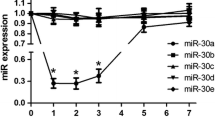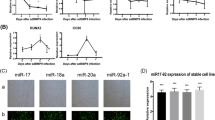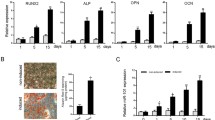Abstract
MicroRNAs (miRNAs) are critical regulators in organ development. Among them, miR-191 is known to be regulated in early embryogenesis and dysregulated in cancer. This role in undifferentiated tissues suggests a possible part of miR-191 also in bone marrow derived mesenchymal stem cells (BMSCs) physiology. Here, we report that miR-191 decreased MMP expression and migration of BMSCs. Conditioned media of miR-191 overexpressing BMSCs block VEGF expression, and inhibit angiogenesis of HUVECs. Under osteogenic culture conditions, inhibition of miR-191 significantly induces bone formation. Moreover, our studies showed miR-191 might influence chondrogenesis of BMSCs by directly targeting CCAAT Enhancer Binding Protein Beta (CEBPB). Taken together, here we demonstrate the role of miR-191 in differentiation, migration and paracrine function of BMSCs.






Similar content being viewed by others
References
Almeida MI, Silva AM, Vasconcelos DM, Almeida CR et al (2016) miR-195 in human primary mesenchymal stromal/stem cells regulates proliferation, osteogenesis and paracrine effect on angiogenesis. Oncotarget 7:7–22
Bartel DP (2004) MicroRNAs: genomics, biogenesis, mechanism, and function. Cell 116:281–297
Bartel DP (2009) MicroRNAs: target recognition and regulatory functions. Cell 136:215–233
Bianco P, Cao X, Frenette PS, Mao JJ et al (2013) The meaning, the sense and the significance: translating the science of mesenchymal stem cells into medicine. Nature medicine 19:35–42
Brodie S, Lee HK, Jiang W, Cazacu S et al (2017) The novel long non-coding RNA TALNEC2, regulates tumor cell growth and the stemness and radiation response of glioma stem cells. Oncotarget 8:31785–31801
Chen S, Xu Z, Shao J, Fu P, Wu H (2019) MicroRNA-218 promotes early chondrogenesis of mesenchymal stem cells and inhibits later chondrocyte maturation. BMC Biotechnol 19:6
Collino F, Bruno S, Deregibus MC, Tetta C, Camussi G (2011) MicroRNAs and mesenchymal stem cells. Vitamins hormones 87:291–320
Copland IB, Lord-Dufour S, Cuerquis J, Coutu DL et al (2009) Improved autograft survival of mesenchymal stromal cells by plasminogen activator inhibitor 1 inhibition. Stem Cells 27:467–477
Cui X, Breitenkamp K, Finn MG, Lotz M et al (2012a) Direct human cartilage repair using three-dimensional bioprinting technology. Tissue Eng Part A 18:1304–1312
Cui X, Breitenkamp K, Lotz M, D’Lima D (2012b) Synergistic action of fibroblast growth factor-2 and transforming growth factor-beta1 enhances bioprinted human neocartilage formation. Biotechnol Bioeng 109:2357–2368
Dangwal S, Stratmann B, Bang C, Lorenzen JM et al (2015) Impairment of Wound Healing in Patients With Type 2 Diabetes Mellitus Influences Circulating MicroRNA Patterns via Inflammatory Cytokines. Arterioscler Thromb Vasc Biol 35:1480–1488
De Boeck A, Pauwels P, Hensen K, Rummens JL et al (2013) Bone marrow-derived mesenchymal stem cells promote colorectal cancer progression through paracrine neuregulin 1/HER3 signalling. Gut 62:550–560
Eskildsen T, Taipaleenmaki H, Stenvang J, Abdallah BM et al (2011) MicroRNA-138 regulates osteogenic differentiation of human stromal (mesenchymal) stem cells in vivo. Proc Natl Acad Sci USA 108:6139–6144
Forte G, Minieri M, Cossa P, Antenucci D et al (2006) Hepatocyte growth factor effects on mesenchymal stem cells: proliferation, migration, and differentiation. Stem Cells 24:23–33
Gao G, Schilling A, Yonezawa T, Wang J, Dai G, Cui X (2014) Bioactive Nanoparticles Stimulate Bone Tissue Formation in Bioprinted Three-Dimensional Scaffold and Human Mesenchymal Stem Cells. Biotechnol J 9(10):1304–1311
Gao G, Schilling A, Hubbell K, Yonezawa T, Truong D, Hong Y, Dai G, Cui X (2015a) Improved Properties of Bone and Cartilage Tissue from 3D Inkjet-bioprinted Human Mesenchymal Stem Cells by Simultaneous Deposition and Photocrosslinking in PEG-GelMA. Biotech Lett 37(11):2349–2355
Gao G, Yonezawa T, Hubbell K, Dai G, Cui X (2015b) Inkjet-bioprinted acrylated peptides and PEG hydrogel with human mesenchymal stem cells promote robust bone and cartilage formation with minimal printhead clogging. Biotechnol J 10(10):1568–1577
Gao G, Zhang X, Hubbell K, Cui X (2017) NR2F2 Regulates Chondrogenesis of Human Mesenchymal Stem Cells in Bioprinted Cartilage. Biotechnol Bioeng 114(1):208–216
Guan X, Gao Y, Zhou J, Wang J et al (2015) miR-223 Regulates Adipogenic and Osteogenic Differentiation of Mesenchymal Stem Cells Through a C/EBPs/miR-223/FGFR2 Regulatory Feedback Loop. Stem Cells 33:1589–1600
Guerzoni C, Bardini M, Mariani SA, Ferrari-Amorotti G et al (2006) Inducible activation of CEBPB, a gene negatively regulated by BCR/ABL, inhibits proliferation and promotes differentiation of BCR/ABL-expressing cells. Blood 107:4080–4089
Hadjimichael C, Nikolaou C, Papamatheakis J, Kretsovali A (2016) MicroRNAs for Fine-Tuning of Mouse Embryonic Stem Cell Fate Decision through Regulation of TGF-beta Signaling. Stem cell reports 6:292–301
Kiezun A, Artzi S, Modai S, Volk N et al (2012) miRviewer: a multispecies microRNA homologous viewer. BMC Res Notes 5:92
Kusuma GD, Carthew J, Lim R, Frith JE (2017) Effect of the Microenvironment on Mesenchymal Stem Cell Paracrine Signaling: Opportunities to Engineer the Therapeutic Effect. Stem Cells Dev 26:617–631
Li H, Li T, Fan J, Li T et al (2015) miR-216a rescues dexamethasone suppression of osteogenesis, promotes osteoblast differentiation and enhances bone formation, by regulating c-Cbl-mediated PI3K/AKT pathway. Cell death differentiation 22:1935–1945
Liu L, Liu H, Chen M, Ren S et al (2017) miR-301b ~ miR-130b-PPARgamma axis underlies the adipogenic capacity of mesenchymal stem cells with different tissue origins. Scientific reports 7:1160
Nagpal N, Kulshreshtha R (2014) miR-191: an emerging player in disease biology. Frontiers in genetics 5:99
Neuss S, Becher E, Woltje M, Tietze L, Jahnen-Dechent W (2004) Functional expression of HGF and HGF receptor/c-met in adult human mesenchymal stem cells suggests a role in cell mobilization, tissue repair, and wound healing. Stem Cells 22:405–414
Pittenger MF, Mackay AM, Beck SC, Jaiswal RK et al (1999) Multilineage potential of adult human mesenchymal stem cells. Science 284:143–147
Ries C, Egea V, Karow M, Kolb H et al (2007) MMP-2, MT1-MMP, and TIMP-2 are essential for the invasive capacity of human mesenchymal stem cells: differential regulation by inflammatory cytokines. Blood 109:4055–4063
Skarn M, Namlos HM, Noordhuis P, Wang MY et al (2012) Adipocyte differentiation of human bone marrow-derived stromal cells is modulated by microRNA-155, microRNA-221, and microRNA-222. Stem Cells Dev 21:873–883
TIAN J, RUI Y-J, Y.-J.XU, S.-A.ZHANG (2018) MiR-143-3p regulates early cartilage differentiation of BMSCs and promotes cartilage damage repair through targeting BMPR2. Eur Rev Med Pharmacol Sci 22:8814–8821
Wang S, Qu X, Zhao RC (2012) Clinical applications of mesenchymal stem cells. J Hematol Oncol 5:19
Xia P, Zhang R, Ge G (2015) C/EBPbeta Mediates TNF-alpha-Induced Cancer Cell Migration by Inducing MMP Expression Dependent on p38 MAPK. Journal of cellular biochemistry 116:2766–2777
Xu W, Ji J, Xu Y, Liu Y et al (2015) MicroRNA-191, by promoting the EMT and increasing CSC-like properties, is involved in neoplastic and metastatic properties of transformed human bronchial epithelial cells. Molecular carcinogenesis 54(Suppl 1):E148–E161
Yang Z, Bian C, Zhou H, Huang S et al (2011) MicroRNA hsa-miR-138 inhibits adipogenic differentiation of human adipose tissue-derived mesenchymal stem cells through adenovirus EID-1. Stem Cells Dev 20:259–267
Zhang XF, Li KK, Gao L, Li SZ et al (2015) miR-191 promotes tumorigenesis of human colorectal cancer through targeting C/EBPbeta. Oncotarget 6:4144–4158
Zhang XF, Sun RQ, Jia YF, Chen Q et al (2016) Synthesis and mechanisms of action of novel harmine derivatives as potential antitumor agents. Scientific reports 6:33204
Acknowledgements
This work was supported by the National Natural Science Foundation of China (81970543, 81570591, and 31800847), State Commission of Science and Technology of Hubei China (ZRMS2018000319), Fundamental Research Funds for the Central Universities (WUT: 2015IB004, 2017IB004, 2017IVA112). The authors declare non-financial conflict of interest.
Supporting information
Fig. S1 Relative miR-191 expression of miR-191 mimic and inhibitor transfected MSCs
Author information
Authors and Affiliations
Corresponding authors
Additional information
Publisher's Note
Springer Nature remains neutral with regard to jurisdictional claims in published maps and institutional affiliations.
Electronic supplementary material
Below is the link to the electronic supplementary material.
Rights and permissions
About this article
Cite this article
Liu, Y., Liu, X., Ye, P. et al. MicroRNA-191 regulates differentiation and migration of mesenchymal stem cells and their paracrine effect on angiogenesis. Biotechnol Lett 42, 1777–1788 (2020). https://doi.org/10.1007/s10529-020-02907-z
Received:
Accepted:
Published:
Issue Date:
DOI: https://doi.org/10.1007/s10529-020-02907-z




